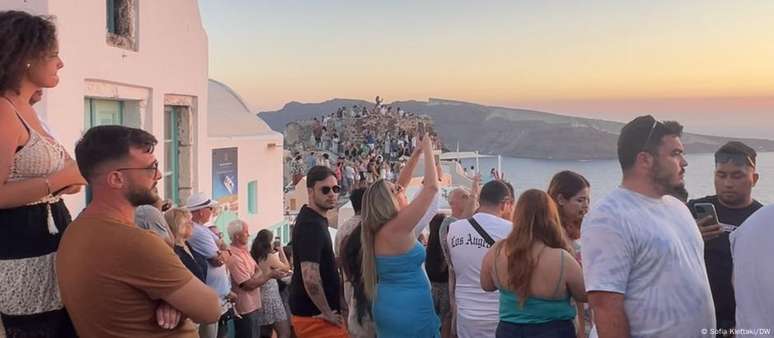Ships account for the majority of tourism at the site, famous for its sunsets and white buildings with blue domes; the mayor is considering limiting the number of visitors to 8,000. Tourists disembark from huge cruise ships at Santorini’s old port. The contrast between the imposing vessels and the small bay of the port is striking.
It’s almost 6 p.m., but the temperature is still above 30 degrees. A small kiosk in front of the entrance to the Santorini cable car sells water to tourists who need to cool off.
The cable car is the quickest way to reach Fira, the picturesque capital of the Greek island. However, the vehicle has only six carriages, each capable of carrying a maximum of six people, and departs every 15-20 minutes.
Tourists queue and wait their turn for almost an hour in the scorching heat.
The above scenario illustrates how overtourism has become a growing problem throughout the Mediterranean region of Europe.
Some places are particularly affected, such as the Spanish island of Mallorca, some towns on the Adriatic coast of Croatia and Kotor in Montenegro.
Of all European tourist destinations, the Greek islands, especially Santorini, are perhaps the ones that suffer the most from mass tourism.
Located in the Cyclades archipelago, Santorini is world famous for its white buildings with blue domes and magnificent sunsets.
Day trips fill the island
A round trip on the cable car costs 12 euros (about R$73.68). Everyone in the carriage is calm and relaxed and the view is breathtaking.
A young couple takes pictures. Others prepare cameras and check equipment. The journey takes less than three minutes.
The calm dissipates as soon as the cable car reaches the top of the hill. Tourists alight from the carriages and before long the narrow, winding streets and alleys of Fira fill with people.
It seems like everyone is in a rush to explore the place. Those who came on a cruise only have a limited time on the island, but several items to check off their bucket list.
Flora Danasi’s shop is located right in front of the cable car exit. Cruise ships are an essential source of income for her, especially in this season.
Compared to recent years, the number of visitors booking accommodation in Santorini and staying for several days has decreased significantly. Industry data shows that bookings have decreased by almost 30% this season.
“The difference between this year and the last two years is huge,” Danasi tells DW. “On days when there are no cruise ships docking, the island seems empty and I don’t do any business.”
Residents feel marginalized
A few streets away from the cable car, the crowds of tourists come to a complete halt. Anastasia Vazeou, who works in a clothing store, laments the effect of tourism on the island.
Vazeou grew up in Santorini, where she still lives, but says she feels marginalized as a resident. “We were advised to spend as little time outdoors as possible during peak cruise hours,” she told DW.
“It’s sad and extreme. Are tourists more important? There are too many people. It’s too much for such a small island.”
Vazeou also works as a receptionist. Guests tell you about the endless waiting times and hours spent in line. “It seems like it’s more about quantity than quality here in Santorini,” she says.
Noise, garbage and pollution
The large number of people who visit the island makes the experience unpleasant for visitors too. Mona Isazad, a teacher in Ireland, is on holiday with her husband on the Greek island. In addition to the unique landscapes, she will take home souvenirs of other aspects of the trip.
“As a tourist, I feel like the island is overcrowded,” he says. “There are people everywhere, especially in Oia and Fira.”
Isazad and her husband noticed that there is a lot of garbage scattered everywhere. “Garbage also seems to be a problem because of the large amount of people. Maybe Greece should think about a way to limit the daily amount of people on the island and other measures to preserve nature, like Venice is doing,” she says.
Even those who work in the hotel industry complain about the noise. “From 8 a.m. to 1 p.m., the alleys are full of groups of tourists. You can barely move. Like sardines in a can,” says Stavros Koukouvelis, describing the hordes of tourists who flock to Oia, in the northwest of the island.
Koukouvelis has been working in Oia for 16 years. The village is a meeting point for tourists as it is the ideal place to enjoy the sunset. The apartments he manages in the village are located directly on the small road that leads to the viewpoint.
“Cruise ship tourists are destroying quality tourism. Even two ships are causing us problems,” says Koukouvelis.
Travelers pay nearly 400 euros (the equivalent of R$ 2,456) per night for these apartments and often complain about the noise caused by the crowds outside their doors.
New limits from 2025
The challenges of cruise tourism in Santorini are not exactly new. This was one of the main problems of Mayor Nikos Zorzos during his first term, from 2011 to 2019.
A 2018 study by the University of the Aegean showed that Santorini can accommodate up to 8,000 cruise tourists per day, as long as their arrivals are staggered throughout the day. Based on this study, a berth allocation system for cruise ships was introduced in 2018.
The project worked well, Zorzos told DW. “But this year the number of visitors was significantly exceeded several times.”
Overcrowding puts enormous pressure on the island’s infrastructure, which is also exhausting for the tourists themselves, especially in hot weather. With this in mind, the mayor says the daily limit of 8,000 visitors will be reintroduced in 2025.
“This year we have at least managed to limit the number of days when multiple cruise ships visited Santorini at the same time,” says Zorzos.
The mayor, now in his second term, is also concerned about construction work on the island and the oversupply of housing.
“This irrational development of the island must stop. Santorini does not need a single more room,” he says. “This is destroying the unique landscape that has made our island famous throughout the world,” he adds.
Social networks versus reality
It’s 6:00 PM in Oia and the streets are packed with visitors heading to the viewpoint to watch the sunset. The crowds move at an ant’s pace. In some places the streets are so narrow that tourists going in the opposite direction have to wait several minutes.
Hardly a word of Greek is spoken. Two Greek musicians are sitting on a white step, playing Greek music on a guitar and a bouzouki (a small lute with a long, thin neck). Most tourists don’t even notice them, they are so busy with their smartphones, filming their next Instagram story and trying to get the perfect shot of the blue-domed buildings, the sea and the sunset.
Everyone wants beautiful photos with as few people as possible, preferably without anyone at all. When the sun goes down, the hustle and bustle dies down. A few minutes after sunset, the lookout is completely deserted. Even so, the musicians continue to play.
Source: Terra
Rose James is a Gossipify movie and series reviewer known for her in-depth analysis and unique perspective on the latest releases. With a background in film studies, she provides engaging and informative reviews, and keeps readers up to date with industry trends and emerging talents.




![Plus Belle La Vie Adher: What awaits you on Tuesday, July 15 in 376 Episodes, July 15, 2025 [SPOILERS] Plus Belle La Vie Adher: What awaits you on Tuesday, July 15 in 376 Episodes, July 15, 2025 [SPOILERS]](https://fr.web.img6.acsta.net/img/60/25/602558db87d6c8410a0a958afc82dcb8.jpg)
-1jyajqq3d5lya.jpg)
-1hrlykellx8ae.jpg)
